#chesapeake & ohio
Text

Township Road 1119, Chesapeake, Ohio.
64 notes
·
View notes
Text
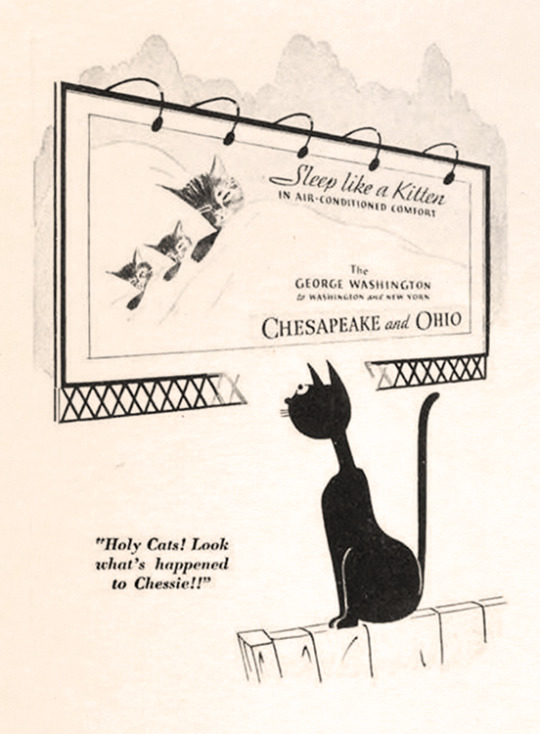
Chesapeake and Ohio Railroad, 1935
125 notes
·
View notes
Photo

Locomotive de type Chesapeake & Ohio ''Hudson'', reconstruites en 1946 à partir de types Pacific d'époque de 1926. - source Richard Stern.
280 notes
·
View notes
Text
While traveling during my holiday vacation, I met someone special!

Say hello to 1601 of the late Chesapeake & Ohio Railway! She’s an Allegheny, one of an engine class bested in size only by the Big Boys.
#c&o 1601#chesapeake & ohio 1601#allegheny locomotive#class h-8#my photos#trains#real life railways#real railway stuff#2-6-6-6#steam engines#steam locomotive#i love her so much
73 notes
·
View notes
Video
Tuckahoe WV Saturday October 12th 1985 1200EDT by bill hooper
Via Flickr:
A single pusher engine assists an eastbound coal train into the Alleghany summit tunnel
#b&o#baltimore & ohio#chessie system#c&o#chesapeake & ohio#1985#trains#freight train#history#tuckahoe#west virginia
58 notes
·
View notes
Text

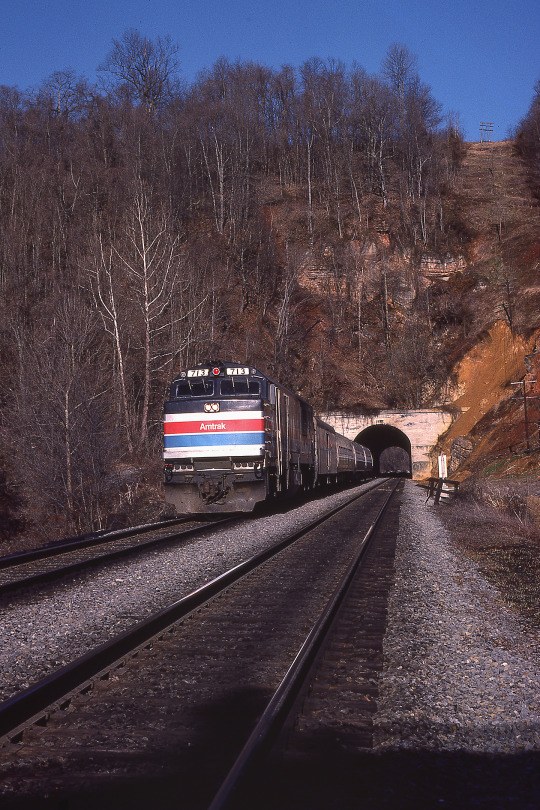
Mud Tunnel
Here are two shots taken at Mud Tunnel on the Chesapeake & Ohio. This spot is just west of Covington, Virginia. We first see a westbound freight and then the eastbound Amtrak James Whitcomb Riley powered by a General Electric P30CH.
Update: someone on FB tells me this locomotive was destroyed later in 1977 when it struck a logging truck near Florence, SC.
Two images by Richard Koenig; taken March 23rd 1977.
#railroad history#railway history#amtrak#jameswhitcombriley#covingtonvirginia#covingtonva#covington#c&o#chesapeake & ohio
54 notes
·
View notes
Text

#photography#black and white photography#photographer on tumblr#photographers on tumblr#photography on tumblr#bw#original photography on tumblr#bw edit#black and white#monochrome#bwphotography#bw photography#scenic#landscsape#landscape#landscapes#landscapephotography#landscape photography#c&o canal#chesapeake & ohio#s22#galaxy s22#samsung s22#s22 ultra
13 notes
·
View notes
Text
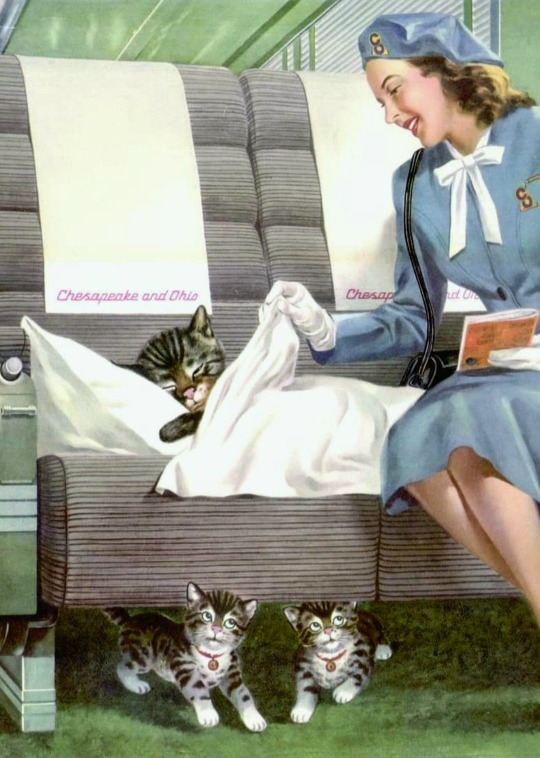


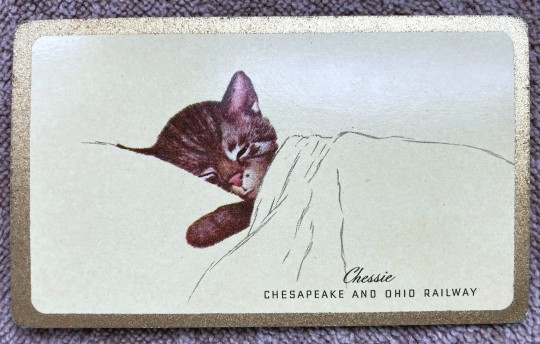


My "Chessie" Kitten, Sylvie.
11 notes
·
View notes
Text
What-If: American Railroads — Section 4: History (part 1)
I’ve finally reached the big part of this whole alternative history; the history itself. The history itself begins before World War II begins in 1939.
June 1935 - After 8 years of delivering 4-6-4 Hudsons and 4-8-2 Mohawks to New York Central, ALCO (American Locomotive Works) takes a new approach to producing steam locomotives; building them in groups rather than one at a time (like what EMD would later do with diesels). Right off the bat, this transition has proven successful as more steam locomotives are being built and delivered at a quicker pace than before. And it doesn’t take long for ALCO’s chief competitor, Baldwin Locomotive Works, to take notice and do the same production pace to stay competitive… and Lima Locomotive Works starts doing the same thing.
1945 - 1946 — After World War II, New York Central orders 25 extra 4-8-4 Niagaras from ALCO (American Locomotive Company). And these 25 extra Niagaras are S1c Niagaras, and these S1c Niagaras burn oil rather than coal. By September 1946, all 25 S1c Niagaras were delivered, bringing the total of Niagaras in New York Central’s fleet to 50.
1946 - 1950 — In May 1946, Lima Locomotives Works proposed a new wheel arrangement for a steam locomotive; 4-8-6. Chesapeake and Ohio got a few of these new 4-8-6’s to test them out, to which C&O have the 4-8-6 wheel arrangement the name, the “Ohio” name. Now C&O usually classified the J letter for their 4-8-4 “Northern” steamers, but they gave the J letter to their 4-8-6 “Ohio” steamers. The first Ohios were given the J-4 class. The new 4-8-6 Ohios proved to be the next step in Lima’s advancements in steam locomotive technology after the 2-8-4 “Berkshire” type. In 1947 to 1948, Chesapeake and Ohio ordered 3 M-1 steam turbine locomotives from Baldwin Locomotive Works and Westinghouse for The Chessie streamliner, and C&O also ordered more 4-8-6 Ohios from Lima as a plan B in case the M-1’s weren’t good enough for The Chessie streamliner. When the M-1 steam turbines proved to be too expensive to maintain, C&O was quick to order more J-4 Ohios, as well as the 4-8-6 J-4a steamers, which had the same streamlined shrouding style as the C&O 4-6-4 L-1 Hudsons. When The Chessie streamliner was launched in 1950, it was a huge success, mostly thanks to the J-4a Ohios. And late by 1950, C&O had 60 Ohios in total in their roster thanks to Lima’s fast production rates (and Lima made and delivered C&O’s Ohios as fast as when they delivered NYC’s L4 Mohawks). However, during all this, it did not take long before other railroads caught wind of the 4-8-6 Ohios and their huge potential.
1947 - 1951 — While Chesapeake and Ohio was testing and using the 4-8-6 Ohio steam locomotives, other railroads began to take notice, and those railroads were… New York Central, Milwaukee Road, Union Pacific and Southern Pacific. When New York Central, Union Pacific and Milwaukee Road ordered 4-8-6 Ohios, Lima worked hard and fast, as fast as when they made and delivered the L4 Mohawks from 1943 to 1944. As for how many, New York Central ordered 50 Ohios, Union Pacific ordered 45 and Milwaukee Road ordered 40. When New York Central’s 50 4-8-6 Ohios were being delivered, they called their 4–8-6 locomotives “Brooklyns”, after the Brooklyn River. 12 of their 4-8-6 locomotives were streamlined for the 20th Century Limited and Empire State Express. 10 4-8-6 locomotives were given the same streamlined shrouding style as the Dreyfuss Hudsons and the last 2 were given the same streamlined shrouding style as the Empire State Express Hudsons. As for the other 38, they remained default and weren’t streamlined and therefore joined the 50 4-8-2 L4 Mohawks and the 50 Niagaras (25 S1b and 25 S1c) in pulling Pacemaker trains (both the Pacemaker passenger trains and the Pacemaker freight trains), Fast Mail trains and milk trains. As for Union Pacific’s Ohios, 15 of their Ohios were given the same streamlined shrouding style as 4-8-2 MT-1 #7002, and Union Pacific even ordered new leight-weight coaches for the Forty-Niner (49’er), fully streamlining the train, and the coaches were given the same colors as the streamlined Ohios. With all that, Union Pacific renamed the train set to the Forty-Niner Express. When Union Pacific fully streamlined the Forty-Niner Express, they gave their streamlined Ohios a new car that would change steam engines; the water tender. With a water tender, a steam locomotive can go for longer distances without stopping to refill on water as often. After Union Pacific introduced the water tender, it didn’t take long for the other 19 railroads; New York Central, Pennsylvania Railroad, Chesapeake and Ohio, Baltimore and Ohio, Illinois Central, Gulf Mobile and Ohio, Norfolk and Western, Southern Railway, Seaboard Air Line, Atlantic Coast Line, Santa Fe, Southern Pacific, Northern. But as for the Ohios of the Milwaukee Road, all 40 of their Ohios were streamlined, with 10 of them receiving the same streamlined shrouding style as the 4-4-2 Class A locomotives, with 10 others receiving the same streamlined shrouding style as the 4-6-4 Class F7 locomotives, with 10 others receiving the same streamlined shrouding style as the 4-6-2 Class F3 locomotives, and the last 10 receiving the same streamlined shrouding style as the 4-6-0 Class G locomotives. Once the 40 Ohios were streamlined, they joined the 4-4-2’s, 4-6-0’s, 4-6-2’s and 4-6-4’s in pulling most of the Hiawathas such as the Twin Cities Hiawatha, Midwest Hiawatha, North Woods Hiawatha and Chippewa Hiawatha. As for Southern Pacific, they ordered 30 4-8-6 Ohios from Lima and all were given the same streamlined shrouding style as the 4-8-4 GS-4 steam locomotives and were put to help the GS-4’s with the Daylight streamliners. Once all these 4-8-6 Ohios were delivered, they proved to be the next one of the great steam engines.
#history#alternate history#chesapeake & ohio#chesapeake and ohio#new york central#union pacific#milwaukee road#southern pacific#steam locomotive
4 notes
·
View notes
Photo

MDOT0001 A special demonstration trip of Maryland DOT commuter equipment passes Chessie System steam locomotive 614 as it departs Camden Station, Baltimore, Md, September 30, 1981. Cab unit 7184 was rebuilt by Morris-Knudsen and redesignated F9PH.
MDOT0001
Maryland Department of Transport
F9PH
A special demonstration trip of Maryland DOT commuter equipment passes Chessie System steam locomotive 614 as it departs Camden Station, Baltimore, Md, September 30, 1981. Cab unit 7184 was rebuilt by Morris-Knudsen and redesignated F9PH. (Louis M . Wassermann)
Sep 30, 1981
#commuter train#c&o 614#chesapeake & ohio 614#mdot#maryland department of transportation#c&o#chesapeake & ohio#chessie system#1981#washington dc#trains#passenger train#history#camden station#baltimore#maryland
21 notes
·
View notes
Text

#my last post popped off so I said fuck it and made Chessie the cat a trans icon#trans rights#chesapeake and ohio#chessie#lgbtq
5 notes
·
View notes
Photo

1941 'Be at ease gentlemen, it's Colonel Washington!' Chesapeake and Ohio Lines
Source: Time Magazine
Published at: https://propadv.com/railroad-poster-and-ad-collection/chesapeake-and-ohio-railway-poster-and-ad-collection/
3 notes
·
View notes
Photo
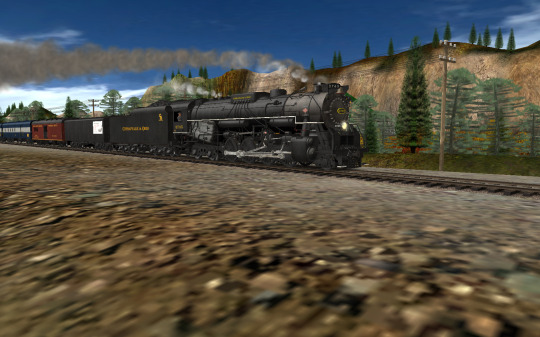
Masquerading as a C&O Kanawha, Nickel Plate Road 765 powers an excursion through Tennessee with a train of CSX Office Cars in tow.
Models and Route by: K&L Trainz, JointedRail, TrainzProRoutes, Auran, and Download Station
#Chesapeake & Ohio#Chesapeake & Ohio Railway#Chesapeake & Ohio Railroad#Nickel Plate Road#NKP#New York Chicago & St. Louis Railroad#Nickel Plate Road 765#NKP 765#Kanawha#765#2765#steam locomotive#trains#Trainz Simulator
2 notes
·
View notes
Text

Another picture of my husband's eye. We left the metaphysical shop at the flea market in Ohio, and I noticed his eyes had gold at the center and I had to get a picture. Side note: does anyone know what this means? Or see anything in the picture?
#my photos#my pics#photographers on tumblr#photography#photooftheday#picoftheday#picture#follow#female photographers#woman photographer#ohio#chesapeake#flea market#metaphysical#pagan wicca#wiccablr#wiccan#wiccalife#paganblr#pagan witch#witchblr#witch community#witchcraft#wicca#beautiful eyes#husband#pagan#does this mean anything#psychic mediums#help
1 note
·
View note
Text

C&O diesel-electric locomotive, engine number 7086, engine type EMD F7 and engine number 7543, engine type EMD F7
Handley, W. Va., July 9, 1953.
24 notes
·
View notes
Text

Tunnleton
This is a westbound Baltimore & Ohio train moving through the East Fork White River Valley in southern Indiana. The small burg of Tunnleton lies above the tracks on the hill.
This B&O line, between Cincinnati and St. Louis, began life as the Ohio & Mississippi. Apparently, the town was created in the mid-1850s when the line was being built—it lies halfway between Big Tunnel and Little Tunnel. The former still exists while the latter was daylighted just prior to the turn of the 20th century.
While this is the B&O, the motive power is of the Chesapeake & Ohio, part of the Chessie System. Both appear to be SD40s.
Image by Richard Koenig; taken October 28th 1977.
#railroadhistory#railwayhistory#b&o#c&o#baltimore&ohiorailroad#chessiesystem#tunneltonindiana#tunneltonin#tunnleton#chesapeake&ohio
45 notes
·
View notes
